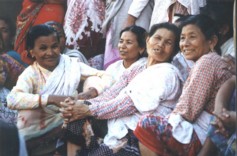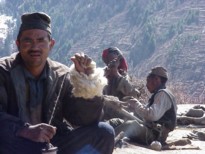
|

|
| Text and Context in Dialogue |

|

|
| Text and Context in Dialogue |
Home > Volume 1 > Number 4: November 2002
|
The Quandary of Caste
The entry of the gospel into a society inevitably involves an encounter with the structure of that society. How do people in that society relate to one another? What form does the structure of that society take? At what level do people feel a sense of belonging and identity? The encounter of the gospel of Christ with Hindu society over the past two centuries has been marked by a high degree of antagonism as the following two stories demonstrate. |

|
William Carey and John Thomas had been working in India for seven years before they saw anyone come to know Christ from the Indian community and Krishna Pal, their first convert, was called upon to suffer much trouble on professing faith. Friends and family denounced him. His teenage daughter, pledged to be married to a young man, was abducted by the man's family (George 1998: 131). Why this strong reaction? The issue, as the missionaries rightly understood, was caste. Carey and his colleagues believed that the holding of caste was incompatible with the Christian faith. He refused to baptise anyone who maintained caste distinctions. Why did caste become the litmus of a new disciple's sincerity? It is clear that the Serampore Trio saw the caste system as an instrument of social and religious oppression. "The chain of caste is broken" jotted William Ward in his diary (ibid.). The position of the missionaries on this issue has had enormous implications for mission right up to the present day.
Coming closer to home and to our own time we will note the story of the esteemed Nepalese pastor Tir Bahadur Dewan in Bhaktapur. After four years of labour in that city the Dewans had only one local Newar widow enjoying regular fellowship with them (Perry 2000: 77). Soon after the Dewans moved to non-mission property, however, three Newar families were baptised and added to the church. But there rapidly followed a crisis described here by Pastor Dewan himself (ibid.).
A Sweeper at the hospital began to come to the fellowship, and he asked for baptism. Some missionaries had the idea that caste must be cancelled out immediately, and bringing this man was the way to do it. But it actually drove people (local Newars) away. They resented the Sweeper being brought into their homes and being told they must eat food with him. I myself refused to eat with him and argued hotly with the others. All the Newars who had come into the church went back and until today no other Newars from the bazaar have openly come to the Lord.
Perry reports that the church in Bhaktapur "was stymied in its growth for the next ten years" after which there was much fruit among the Tamang people of Bhaktapur's hinterland but never any significant movement of Newars (ibid.: 78).
The question I want to address in this article is, Was that necessary? Was the action of the missionaries in both cases responsible? Did they understand the social system of the people they were living among? To answer this question we need first look at the term caste and then look at three major theories of caste from the anthropological literature. We will then examine whether the issue of caste is the same today as it always has been and explore some of the missiological implications.
|
The term caste
In the analysis of caste we must begin by carefully choosing our terms. The English word caste comes from the Portuguese for "species'"castas. It has been argued, by some, that the use of such a foreign term prejudices the inquiry before we begin. Isn't it better, they ask, to use the terms that are actually used "on the ground" rather than bring in a word that carries so much potential baggage with it from outside? They have called, therefore, for an abandonment of the word caste in favour of indigenous terms such as jati and varna. The two indigenous terms, at least as they are usually glossed in Nepal, represent somewhat overlapping semantic fields. According to the Vedas there are four varnas brahman, kshatriya, vaishya and shudra. Everyone "knows" that there are vastly more actual groups of people, that they normally call jat or jati. So various attempts have been made to fit the empirical data (jati) into the textual framework (varna). Pritvi Narayan Shah's famous aphorism that "Nepal is a garden of four varnas and sixty-four jatis' is one such attempt. The difficulty people have translating such a adage speaks volumes about the conceptual morass that it throws up. So there is a major obstacle here: resorting to native terminology throws up its own problems because definitions of jati and varna are not universally accepted. What profit can we get from an analysis of these terms? Taking the term jati it is apparent that people use the word in different ways in different contexts. Nepalese, for instance, will use the term not only in reference to people but also in reference to animals and plants. They will distinguish, then, between two different jatis of banana. Again, I have often been told, by informants who were perhaps somewhat irritated with my constant interrogation, that "There are only two jatis men and women". The broad usage of the word, then, does not permit us to define it too narrowly. |

|
There has been much argument over the relation of the terms jat/jati with varna. It is clear that the terms are not synonymous. Many attempts have been made to fit substantive groups into the varna scheme although these attempts have ended in utter failure. At the coronation of the late King Birendra it was decided that a representative of each of the varnas should take part. The choice of a Limbu to represent the shudras, however, strikes the writer as unthinkable in the present political climate. To Louis Dumont, whose theory we will look at later, this does not seem to be a problem as neither jati nor varna, in his scheme, need represent actual discreet groups. But the two terms are used differently. There may, for instance, be two or three types of Brahman in a given locality, as there are in Newar society. If these castes have no marriage relations and do not eat together, however, there is no reason to group them together. By calling all such groups brahman we are labelling them as such even though they have no reasons to accept one another as such. Rather, then, varna is an ideal, a notion, to which various groups, in the mind of the local person belong. It is meaningless to try to fit actual, substantive caste groups into some definitive varna frame. This will always be a contentious issue. Varna, then, is more a function of self- and other-consciousness reflecting and, to a certain extent enforcing, certain patterns of behaviour that are thought to be suitable to such a person. Declan Quigley, in his brilliantly reasoned book The Interpretation of Caste, argues that those from a single jati could belong to any varna in the sense that they may take on the roles that traditionally belong to those varna (1993: 139). So the wealthy Tamrakar Coppersmith who insists that Tamrakars are kshatriya does so not because all Tamrakars fit that ideal but because some, as his family, do. The Tamrakar can become a kshatriya by gaining dominance over other groups and emulating the "true" kshatriya, he may be a shudra if he simply provides copper pots for the other jatis, or he may be vaishya by emulating the role of the kshatriya without having gained any real dominance. In such case the Tamrakar shopkeeper is the paradigmatic vaishya. This explains how Tamrakars can see themselves in such different status positions and yet belong to one acknowledged marriage circle–three varnas, one jati .
Quigley deals with this at length: "The sense of jati is of those people who are in some fundamental way alike because of their common origins, and fundamentally different from those who do not share those origins" (ibid.: 4). "The sense of varna is quite different. The basic idea is not of birth but of function, and not simply any function, but one which is necessary to ensure that social harmony and cosmic stability are maintained" (ibid.: 5).
|
The materialist theory of caste
How may we conceptualise the relation between occupation and caste? Advocates of the materialist theory of caste, argue that caste is based simply on the distribution of power among the various groups that go to make up the society. A person's occupation, according to this view, gives a person a certain ritual status from which he can escape simply by changing his job. Gerald Berreman, whose book Hindus of the Himalayas (1972) has been highly influential, takes such a position. Colin Rosser, who studied the caste system of the Kathmandu Valley, is another for whom, quite simply, differing status positions are derived from the distribution of political and economic power. |

|
For my own part, I take "caste" simply to be a form of social stratification in which the necessary statements and judgements about relative status are couched predominantly in a traditional ritual language. In a particular caste system the differing status positions of the component groups are in my view derived ultimately and basically, as in all systems of hierarchical stratification, from the distribution of political and economic power within that system. The language of ritual behaviour is used conventionally to express and validate status achieved through and based upon the operation of political and economic factors. (1966: 69, italics his)
But, there are some major problems with this theory. It cannot account, for instance, for the fact a Parbatiya Goldsmith (Sunar) is considered untouchable whereas a Newar Goldsmith (Shakya) is considered high caste. The same is true of the Newar Blacksmiths (Nw. Nakahmi), many of whom have hired Untouchable Parbatiya Blacksmiths (Kami) to work for them in the car repair and steel industries of the Valley. They may both be Blacksmiths and even work together but that is as far as their relations extend. They neither intermarry nor have any ritual relations. If a man has a job as a coppersmith it does not mean that other coppersmiths will want to give their daughter in marriage to him. These days, many of the men who work copper in Lalitpur, the traditional centre of this industry in Nepal, are Kami with whom a Newar Coppersmith (Tamrakar) will not normally have any social or ritual relations. Furthermore, a change in occupation may be possible in the modern economy but it will not generally improve that person's ritual status.
|
The idealist theory of caste
Dumont's works, culminating in the monumental Homo Hierarchicus (1980 [1972]), have been very widely read in the field of South Asian studies and have had a profound impact on the Western understanding of caste. Dumont's own starting point is the definition of caste by Bouglé (1927). The caste system divides the whole of society into a large number of hereditary groups, distinguished from one another and connected together by three characteristics: separation in matters of marriage and contact, whether direct or indirect (food); division of labour, each group having, in theory or tradition, a profession from which their members can depart only within certain limits; and finally hierarchy, which ranks the groups as relatively superior or inferior to one another. |

|
Bouglé based all three of these together on the opposition between the pure and impure (Dumont 1980: 21, 30).
Dumont is concerned that we not impose our modern, individualistic perspective on Hindu society and thus reduce caste to just one form of what we have in the West. Because we (moderns) are individualistic, he suggests, we always perceive hierarchy in terms of inequality. Traditional society, in contrast, perceives hierarchy in terms of holism. And in order to do proper comparative sociology (anthropology) we need to first understand caste holistically. Dumont's position, simply put, is that the caste system is a hierarchy based on the opposition of purity and impurity with the Brahman on the top and the Untouchable on the bottom: "superiority and superior purity are identical: it is in this sense that, ideologically, distinction of purity is the foundation of status" (ibid.: 56). Dumont defines hierarchy as the "principle by which the elements of a whole are ranked in relation to the whole," (ibid.: 66). This Dumont calls holism.
One of the foundational elements of Dumont's theory is that ritual purity and power are divided at the top between the brahmans and the kshatriyas. In this way, argues Dumont, Hindu society is unique and cannot be compared with other social systems. The king, as a kshatriya, Dumont asserts, is ‘deprived of any sacerdotal function" as only the brahman may perform the sacrifice (ibid.: 68). It is this assertion that enables Dumont to assert that "In theory, power is ultimately subordinate to priesthood" (ibid.: 71).
Dumont is concerned to reduce the ethnographic data to the level of ideology. For him the issue of whether castes are actual, discreet, substantial groups is not an issue. But it is my contention that this is an important issue. If discreet caste groups are no more than a product of the sociological imagination then the caste system, as Dumont asserts, may rightly be reduced to an ideology. But if there are substantial, discreet groups that we can label castes it calls into question his whole approach. It does not deny the involvement of ideology, but it does suggest that ideology is not the whole story. Dumont's theory, then, is not powerful enough to explain how one can be a Brahman, i.e. a member of a particular kinship group, and yet not be a brahman, i.e. a practising priest. Dumont's work leads one to assume that the two words mean the same thing.
|
The problem with Dumont
Dumont's insistence on a dichotomy of status and power between brahman and king is at the centre of his theory. But there is a major problem here and that is that the Brahman's association with the priesthood is something degrading not elevating. Why else would a Brahman rather be a businessman or farmer than a priest? The gift that is given to the Brahman priest by the family of the deceased, for instance, is understood to be inauspicious. "The supremacy of the Brahman is in spite of his association with priesthood, not because of it", says Quigley (1993: 61). Quigley draws on the work of Gloria Raheja who argues that political institutions are always expressed in an idiom of ritual: "the organisation of castes around the king or village-level jajman [patron] is not simply a matter of political power but of the ritual maintenance of the ordered life of the realm" (Raheja 1988: 504). |

|
For Dumont the basic principle of caste is that of hierarchy but in most contexts, on the ground so to speak, hierarchy is not stressed at all. What is stressed is the institutional and conceptual centrality of the dominant caste, not the hierarchical superiority of the Brahman.
Moreover, the issue of kinship is of utmost significance. "It is not so much that everyone has (or ever had) a caste-specific occupation in the first instance. Rather, everyone belongs to kin groups whose traditional function it is (or was) to provide certain functionaries for certain occasions" (ibid.: 91).
The marriage pattern of dominant castes in Nepal and India is what is termed hypergamous that is marrying women "up" the hierarchy. What comes out of the ethnographies, however, is that middle-status groups are anxious to give their daughters in marriage to kshatriyas not to brahmans. The phenomenon of hypergamy, therefore, demonstrates that lower castes are eager to rise to the status of the kshatriya rather than the brahman. "In what sense, then," asks Quigley "are Brahmans the highest caste if there is no aspiration for social mobility into this group" (ibid.: 101)?
Caste and kingship: Hocart's theory
After exposing the inconsistencies and inadequacies of Dumont's theory Quigley goes on to expound the view of Arthur Maurice Hocart (1950). "there are four key ingredients in Hocart's interpretation of caste: kinship, domination, ritual and decay (pollution)" (Quigley 1993: 126). These can be reduced to two: kinship and kingship (ibid.: 127). Quigley summarises Hocart's position as follows: There are two kinds of families: those who rule and those who are ruled. It is the ritual task of the ruled to keep their rulers free from pollution and the ritual task of the rulers to ensure that they do. Or: those who rule must be pure (ibid.: 122). The key to Hocart's theory is the centrality of the king. This centrality is repeated as kshatriya nobles and powerful landowners act as petty rulers. The other key element of the caste system, as we have seen, is the bond of kinship. It is not as important for a particular caste to know where they are on some hypothetical ladder as it is that they have a sense of belonging in their group. These two factors: the centrality of the king and the kinship bond within the caste are the most important elements in describing caste systems (for they are plural). This, then, is the "royalist" model of caste.
Caste, according to Hocart, is a sacrificial system. It is the sacrificial function that is central to caste. "Castes are merely families to whom various offices in the ritual are assigned by heredity" (Hocart 1950: 20 quoted in Quigley 1993: 116). It is Hocart's claim that the Kshatriya are at the apex of this sacrificial system. It is this royal function that is reproduced throughout society.
Some might object that, if this is the case and Kshatriyas are actually "higher" than Brahmans, then why does it often seem to be the exact opposite? Quigley asserts that there was a shuffling of the categories during colonial rule because the new rulers took the part of the king except in the matter of adjudicating caste (ibid.: 123-126). Assuming that this was the territory of the Brahmans the colonial rulers left it to them. This had the effect of elevating the position of the Brahman and demoting the Kshatriya. The transition in Nepal seems to have come with the overthrow of the Ranas and the institution of, for the most part, Brahman-controlled political parties.
But how did the institution of kingship lead to caste? Caste emerges out of the interplay between the two antagonistic forces of kingship and kinship. Kingship is centripetal whereas kinship is centrifugal. "Caste results when kingship attempts to assert itself against kinship but ultimately fails because the conditions do not allow for stable kingdoms" (ibid.: 129). Caste solidarity can operate against the power of the state. Quigley argues that "The pervasiveness of notions of pollution and separation derives from the need to make kinship boundaries unambiguous as a way of creating stability in this political climate" (ibid.).
At this point it is important to note that Hindu society does not possess one monolithic ideology. People may believe and behave in many different ways and still be considered a Hindu. It is this that makes it impossible to think of Hinduism as a single religion as one might think of, say, Judaism, Islam or Christianity. A single caste-based society, then, may encompass groups of people that have very different and contradictory cultures and religions. The royalist model of caste is structural, not ideological.
|
The central concept of order
The caste system is ultimately not about hierarchy but about order. Quigley again: The primary function of the king is provide order. Through the sacrifice, which he commands, he continually regenerates the order of the universe; he controls the gods and natural forces which are otherwise uncontrollable. Ritual is essentially a question of order; order is essentially a question of ritual. He who controls the order controls the ritual; he who controls the ritual controls the order." (ibid.: 139) |

|
He goes on, "Caste is a means of creating order through their combination where the alternative would be no order at all" (ibid.: 141).
To sum up these three interpretations of caste, the materialist does not adequately explain the importance of ritual, and the idealist overstates its importance. The royalist, however, "ploughs a furrow" through the middle.
Idealists like Dumont make the mistake of thinking that purity must be about ultimate values when it is about kinship and power, about making boundaries to include and exclude. His materialist critics make the mistake of thinking that hierarchy must be about material wealth when in fact it is about order." (ibid.)
Caste today
Careful observers of caste today agree that the social system remains strong despite (or should one say because of?) the impact of modernity upon it. Caste, however, is going through a monumental change. In Nepal, as in India (Fuller 1996) while intercaste relations have declined intracaste solidarity has increased (Ishii 1987). Many castes are organising themselves in ways that they never did before. Among the Newars, to take one example, there are so far organised bodies representing the Brahmans, Vajracaryas, Kamsakars, Maharjans, Nakarmis, Manandhars, Citrakars, Tandukars, Khadgis, and Kapalis as well as Tamrakars and Rajkarnikars (Gellner n.d.: 16). In future these associations may well become, as they have in India, vote blocs that have significant political ramifications. Even if they don't, their social significance seems to be on the increase. Caste is far from dead.
Missiological implications
What are the implications of these observations for ministry among the majority community in Nepal? Firstly, we must be very careful to not try to fit any particular community into some supposedly pan-Hindu, or even pan-Nepalese social structure. Every expression of the caste system has its own characteristics. Each community is unique and the cross-cultural worker should give special attention to the particular manifestation of caste in which he finds himself.
Secondly, we must understand that for many Hindus a general attack on caste constitutes an attack on the very foundation of their society. It should be no surprise, therefore, if such an attack provokes a strong reaction.
Thirdly, the importance of caste solidarity must give us a very high respect for particular caste relationships. The caste, after all, is an extension of the family. Any perceived attack on caste rules constitutes an attack on the very existence and identity of the group. If this is strongly resisted we should not be surprised. For the majority of Hindus, even today, caste is the single most important aspect of their identity.
Fourthly, if the caste system is not essentially an ideological system then a change of ideology on the part of a new bhakta of Christ does not of itself demand a repudiation of the system. That is, if caste is not linked to any one system of thought–any one religion in the familiar Western sense of the word–a change of belief may not necessitate a change of social identity. Caste is a structure not a philosophy. It is not spiritual immaturity that leads a Nepalese follower of Christ to want to marry a member of his own caste.
Finally, having said this, it is also clear that, in modern Nepalese society, there is an opinion that caste prejudice is wrong. It is difficult to assess quite how deeply this opinion is felt or whether it is merely an expression of political correctness. Is it possible to affirm caste, in some way, without affirming prejudice? If caste is primarily an expression of identity in much the same way as tribe is for, say, the Kulung Rai, then we should have no problem affirming it. This distinction between caste belonging and caste prejudice is important for us to grasp. It is just this distinction that the Serampore trio and the well-meaning missionaries in Bhaktapur failed to catch. We, however, ignore this at our peril. Those of us who are foreigners to this country owe it to our Nepalese friends to hold this distinction uppermost in our minds as we counsel our friends in their attempts to apply Biblical truth to the current context. Nepalese followers of Christ, in their desire not to seem regressive and prejudiced, must be careful not to judge their own tradition by the misunderstandings of their foreign friends. All of life, including caste, must be brought to the bar of Scripture to be judged. But let us make sure we understand the phenomena we are judging before we condemn it.
References Cited
Voice of Bhakti welcomes interaction with its readers. If you have a comment please email the editor at the address below. Mark Johnson, editor